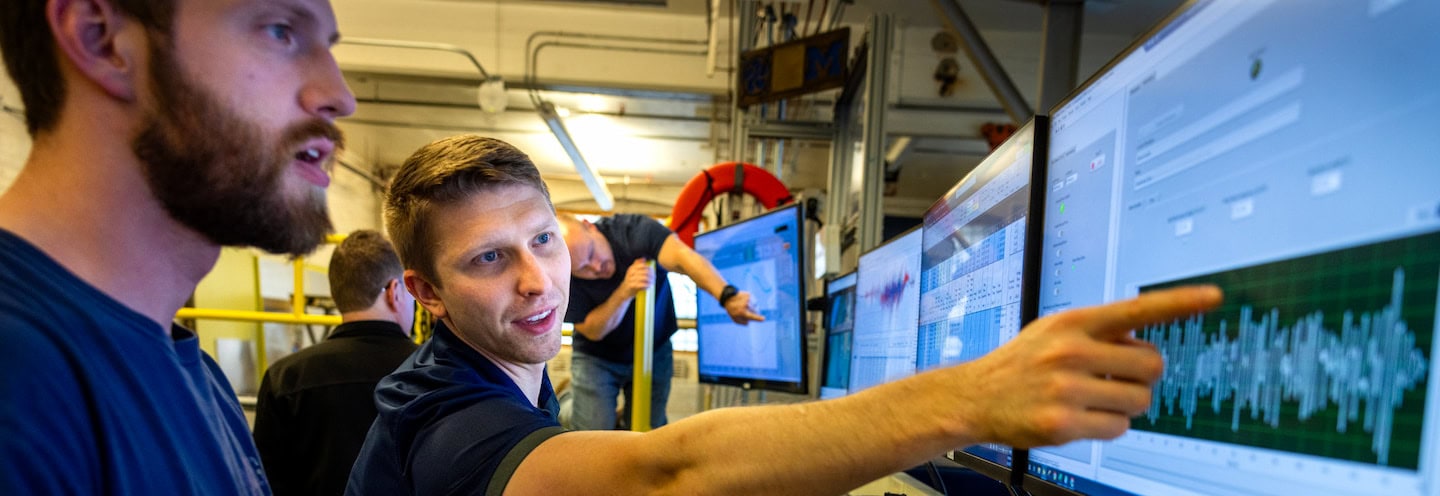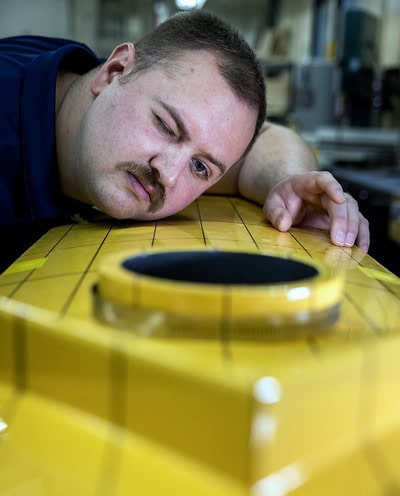
Stealthy ship hull cuts through waves like butter
Borrowing from drug-smuggling subs, Michigan engineers are helping the Navy design autonomous ships that blend in with the ocean surface.
Story By:
PHOTOS AND VIDEO BY: MARCIN SZCZEPANSKI
Experts
Matthew Collette
Jason Bundoff
Jim Smith
Zachary Campeau
Video Transcript
Matthew: Autonomy is now ready to be used in major conflicts. The U.S. is very interested in adapting the technology for dangerous missions or missions that don’t have enough priority necessarily to have a human crew at risk.
My lab and this particular project are looking at a low-profile vessel, which is a vessel that’s designed to kind of hide by being very close to the surface of the water. Vessels like this are used by drug cartels to move drugs around the world, so for those applications, we want to be able to understand how to detect the vessels better.
But militaries are also interested in this technology. If they have to move something covertly around the world, they’d like to understand how to design these vessels successfully.
We’ve seen in the war in Ukraine, especially the Ukrainian Navy, has used autonomous vessels successfully in the Black Sea to attack Russian vessels in harbor and in coastal regions. So, we have the ability to use autonomy in new ways.
There’s interest from both the Navy and the commercial world about potentially reducing the number of mariners on board to make the vessels simpler and more efficient.
In this project, we’re trying to understand the basics of the resistance — how hard it is to move through the water — both in calm water and with waves, and also how it might move differently than a conventional-looking vessel.
In the long term, we’re hoping that this would lead to the more successful design of vessels for the U.S. Navy and an improved ability for the U.S. government to detect vessels like this that might be operated by others.
We have a lot of work to do before we’re ready to say we can make a transoceanic commercial ship fully autonomous.
The sharp bow of a nearly ten-foot-long model ship pointed ahead in the 360-foot towing tank in the Aaron Friedman Marine Hydrodynamics Laboratory. While the model’s sleek, yellow body was typical, its position in the water was unorthodox. The deck was nearly parallel with the water’s surface. Only a few inches of the hull were dry.

Shipbuilding
Explore more shipbuilding and maritime innovations from Michigan Engineering
When the deck of a metal ship sits so low, it easily blends in with the surrounding water and literally hides behind waves. Such low-profile vessels have been used by drug smugglers to covertly move cocaine for over twenty years.
On a platform a few feet above, engineers prepared the model for a test cruise down the tank. The Department of Defense has funded the Michigan engineers’ tests in the hope that they could help pluck a thorn from the Coast Guard’s and Navy’s sides, and turn it into a boon. The Coast Guard and Navy want to improve their methods for detecting low-profile vessels, and the Navy is hoping to design their own autonomous versions that could run resupply missions without putting sailors’ lives at risk. U-M is one of the few American universities with the facilities to assist.

“Drug smugglers are making these vessels for their own use. They aren’t concerned about modeling the hydrodynamics and making public engineering models,” said Eric Gimple, a recent Master’s graduate in naval architecture and marine engineering and a research assistant working on the project.
“We really have no information about these vessels beyond a couple of small projects,” Gimple said. “We can set a baseline by building and testing a physical model.”
To test their model, which was about six times smaller than a real vessel, the engineers loaded it with varying amounts of cargo and pulled it through waves of various size and complexity. Their experiments are revealing how the vessel behaves in different kinds of waves, as well as the optimal locations for the sensors that an autonomous ship needs to pilot itself.
For Gimple, the work is not just about engineering, but honoring his father, Capt. Matthew Gimple. Before Capt. Gimple retired from the Coast Guard in 2019, he helped capture low-profile, narco subs—including the first that the Coast Guard ever detained at sea.


“My dad came back with all these wild stories about how he’s at sea, stopping drugs and helping people,” said Gimple, who also served in the Coast Guard for seven years before studying engineering at U-M. “I was really proud to follow him into the Coast Guard. So, I thought it was a rather serendipitous fit that the type of vessel that my dad told me about would be something that I would get to research.”
For their experiments, the engineers attached the model ship to the tank’s carriage—a large, wheeled platform that tows models down the tank on a set of steel rails that flank the tank. The model was connected to the carriage with a metal mast. Force sensors in the mast measured how strongly water resisted the ship’s forward motion. The engineers also switched on lasers, pointing them at the model’s center and stern to measure how the ship might rock and bob.
Once everything was in the proper position Jason Bundoff, lead engineer at the Marine Hydrodynamics Laboratory, clapped his hands to mark the start of their test like a film crew using a clapperboard. A mechanical whirring sound grated against the engineers’ eardrums as a steel paddle at the far end of the tank started churning into the water. Waves roughened the glass-like surface, mimicking the ocean. A little over a minute later, the waves reached the model ship, and project engineer Jim Smith fired up the carriage’s electric motors.
The carriage pulled the model ship and the engineering team forward at nearly four miles per hour, matching the behavior of a full-sized vessel moving eight knots.


Zachary Campeau (left), the Marine Hydrodynamics Laboratory’s lead electrical engineer, and Jason Bundoff (center), the lab’s lead engineer, discuss the model’s performance with Matthew Collette (right), a professor of naval architecture and marine engineering.
Conventional vessels would have plowed through the water, breaking it into tumbling waves and sea spray. But the model was so slender and close to the surface that it cut through the water like butter, creating a splash-free bow wave that looked like a smooth ripple near the front of the ship. As the ship cut through more waves, water spilled onto the foredeck, coating it in a thin layer that flowed down the length of the deck before parting at a wavebreak near the center mast.
Video Description
Michigan engineers are helping the U.S. Navy design autonomous ships that blend in with the ocean surface by literally hiding behind waves. Such low-profile vessels have been used by drug smugglers to covertly move cocaine for over twenty years. Now, the Navy wants to borrow the design to run resupply missions without putting sailors’ lives at risk. U-M is one of the few American universities with the facilities to assist.
They tested their design’s performance by pulling a six-foot-long model down the 360-foot tow tank in the Aaron Friedman Marine Hydrodynamics Laboratory on central campus. A metal paddle at the end of the tank created waves that mimicked a typical day on the real ocean.
As the ship cut through more waves, water spilled onto the foredeck, coating it in a thin layer that flowed down the length of the deck before parting at a wavebreak near the center mast. The test suggests that the wavebreak could be pushed forward to reduce the load on the deck by keeping it drier.
Video by Jason Bundoff, lead engineer at the Aaron Friedman Marine Hydrodynamics Laboratory.
“It’s fascinating how the waves are coming over the deck so smoothly,” said Matthew Collette, a professor of naval architecture and marine engineering and the project’s principal investigator. “The location of that wavebreak may turn out to be really important. It’s possible that if we pushed it forward, we could reduce the load on the deck by keeping it drier.”
Additional runs uncovered more surprises—the boat sometimes rocked harder than the waves rolled. The instability is likely caused by the small amount of watertight space above the waves, which normally creates reserve buoyancy that balances the ship. The next step is computer simulations that extrapolate their measurements to stormier seas and larger vessel sizes, which the Navy can use in future designs.
“It’s been interesting to take this thing that has only been a detriment to the country and try to find a positive use for it,” said Gimple.




